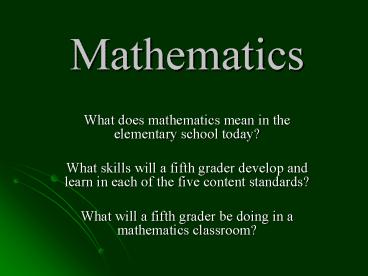Mathematics - PowerPoint PPT Presentation
1 / 17
Title:
Mathematics
Description:
... number and operations, algebra, and geometry receiving the greatest, and equal, emphasis. ... Geometry ... using coordinate geometry and other ... – PowerPoint PPT presentation
Number of Views:271
Avg rating:3.0/5.0
Title: Mathematics
1
Mathematics
- What does mathematics mean in the elementary
school today? - What skills will a fifth grader develop and learn
in each of the five content standards? - What will a fifth grader be doing in a
mathematics classroom?
2
What is mathematics?
3
Mathematics Today
- Mathematics today means more than just
memorizing basic facts and completing assigned
computational tasks. - Students are provided with opportunities to learn
concepts in five different content standards.
4
The Five Content Math Standards
- The five NCTM content standards are number and
operations, algebra, geometry, measurement, and
data analysis and probability. - The following slide depicts a graph developed by
the National Council of Teachers of Mathematics
to reflect the amount of time, or emphasis, that
should be placed on each of the five content
standards during a students years in Pre-K-grade
2, grades 3-5, grades 6-8, and grades 9-12. - The graph shows how the emphasis placed on each
of the content standards is transformed as the
student grows older. - Concentrate on the vertical line placed at the
end of the grade 3-5 band. Notice that the
amount of time placed on each of the five areas
is approximately the same with number and
operations, algebra, and geometry receiving the
greatest, and equal, emphasis.
5
Emphasis Given the Five Content Standards
- NCTMs Principles and Standards for School
Mathematics, 2000, p. 30.
6
What skills will a fifth grader develop and learn
in each of these content standard areas?
7
Number and Operations
- Understand numbers, ways of representing numbers,
relationships among numbers, and number systems - Understand meanings of operations and how they
relate to one another - Compute fluently and make reasonable estimates
8
Algebra
- Understand patterns, relations, and functions
- Represent and analyze mathematical situations and
structures using algebraic symbols - Use mathematical models to represent and
understand quantitative relationships - Analyze change in various contexts
9
Geometry
- Analyze characteristics and properties of two-
and three- dimensional geometric shapes and
develop mathematical arguments about geometric
relationships - Specify locations and describe spatial
relationships using coordinate geometry and other
representational systems - Analyze transformations and use symmetry to
analyze mathematical situations - Use visualization, spatial reasoning, and
geometric modeling to solve problems
10
Measurement
- Understand measurable attributes of objects and
the units, systems, and processes of measurement
(including time and money) - Apply appropriate techniques, tools, and formulas
to determine measurements
11
Data Analysis and Probability
- Formulate questions that can be addressed with
data and collect, organize, and display relevant
data to answer them - Select and use appropriate statistical methods to
analyze data - Develop and evaluate inferences and predictions
that are based on data - Understand and apply basic concepts of probability
12
What do you do when you are doing mathematics?
13
Doing mathematics includes
- Using higher order thinking skills to analyze and
solve problems - Collaboratively sharing ideas and discovering
solutions to problems - Communicating ideas, strategies, and solutions
both orally and in writing
14
Doing mathematics includes (cont.)
- Using manipulatives (including calculators) for
exploration and discovery - Making connections to other mathematical concepts
and academic disciplines - Developing an understanding of concepts being
studied
15
Doing Math with Process Standards
- The goals of NCTMs process standards are
integrated throughout the teaching/learning of
the five content standards. - The five process standards are
- Problem solving
- Reasoning and proof
- Communication
- Connections
- Representation
16
Where can I find more information about the NCTM
Math Standards and the HCSDs fifth grade
benchmarks?
- NCTM Standards
- http//standards.nctm.org/document/index.htm
- HCSDs Fifth Grade Benchmarks
- http//www.harlan.k12.ia.us/mrsc/fifth_grade_mat
hematics.htm
17
- I hear and it helps a little,
- I see and the ideas begin to form,
- I do and the ideas becomes real to me,
- I do, see, and hear, and I
understand, - I talk about it and I
understand more, - I apply it and I see its
value. - - Dr. Phares G. ODaffer































